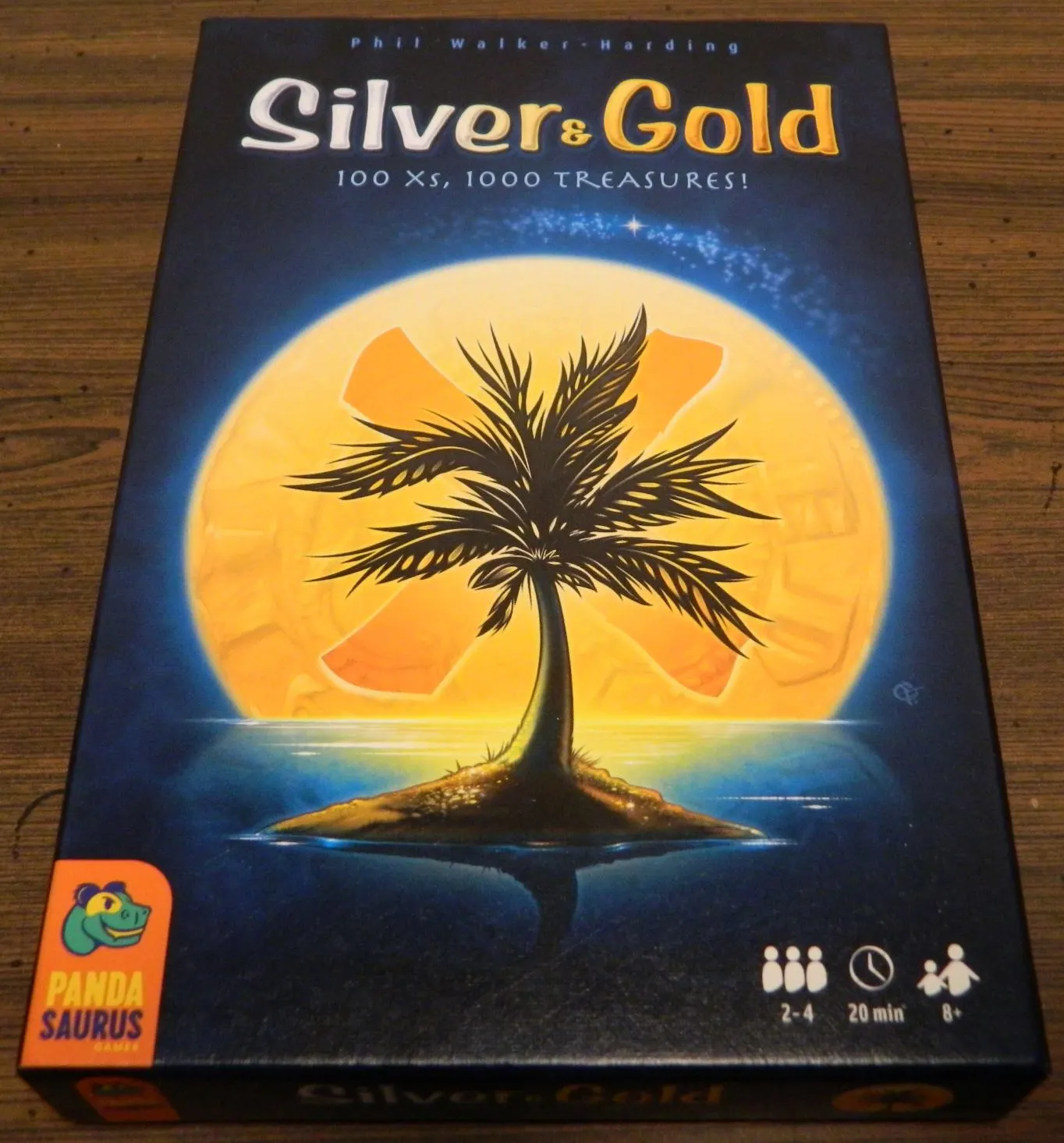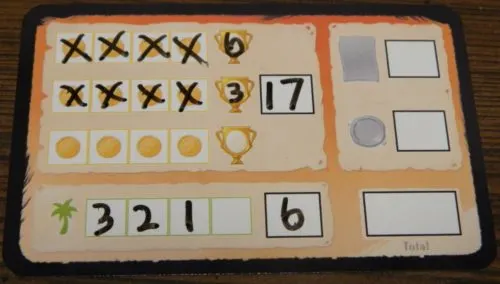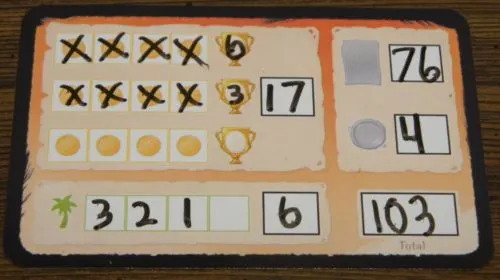Regular readers of Geeky Hobbies probably already know that we are huge fans of Phil Walker-Harding’s games. As of the writing of this review we have reviewed four of his games and the lowest rating that we gave any of the games was a four. That is quite impressive especially since we haven’t even checked out some of his highest rated games. I would say at this time he is one of my favorite board game designers. With that in mind today I am looking at another of his games Silver & Gold which was released last year. Between the flip and write mechanics, the buried treasure theme, and the designer behind the game; I had pretty high expectations for the game. Silver & Gold may be a little simple for some hardcore gamers, but I see a game that crafts a unique mechanic into a fun and quick game that the whole family can enjoy.
How to Play Silver & Gold
Setup
- Each player takes a marker and a score card. They should place these face up in front of them on the table.
- Shuffle the Treasure Cards and deal four to each player.
- Each player will choose two of their Treasure Cards to keep. They will place these two cards face up in front of them. The other cards should be returned to the deck of Treasure Cards.
- The remaining Treasure Cards are shuffled and are placed face down on the table. The top four cards from the deck are turned face up.
- The eight Expedition Cards are then shuffled and placed in a face down draw pile.
- Place the Round Card in the middle of the table.
- The last player to search for buried treasure will start the game as the first player. At the end of each turn this role will pass to the next player clockwise.
Playing the Game
Silver & Gold is played over four rounds. Each round consists of seven turns. A turn consists of three steps.
- Reveal An Exhibition Card
- Cross Off Boxes
- Complete Rows of Coins or Treasure Cards
Reveal An Exhibition Card
The current first player will take the top Exhibition Card from the draw pile and turn it face up so all of the players can easily see what is written on it. When placing this card on the table it should cover up any other previously revealed Exhibition Cards from the current round.
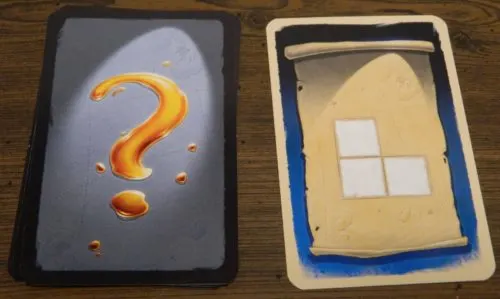
This Exhibition Card has been flipped over. Each of the players can cross off three spaces from one of their Treasure Cards in this pattern.
Cross Off Boxes
For this step each player will have the opportunity to cross off some of the spaces from one of their Treasure Cards. The Exhibition Card that was revealed will show a design of boxes. This design will show the pattern that players will be able to cross boxes off one of their Treasure Cards. The design can be rotated or flipped in any direction, but the pattern must be followed exactly when crossing off spaces. When crossing off spaces a player can never cross off a space that has already been crossed off.
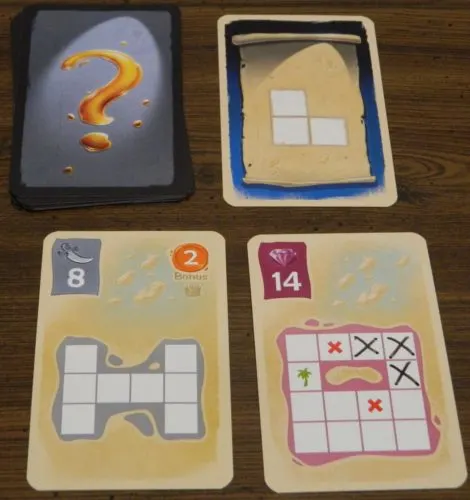
This player has used the revealed Exhibition Card to cross off the three spaces from the purple card.
If a player can’t use the full design or they don’t want to use it, they can instead cross off one box on one of their Treasure Cards.
The Treasure Cards have a few special spaces which activate special abilities when they are crossed off.
X Symbols
When a player crosses off a square featuring a X symbol they will immediately cross off a box (that has not already been crossed off) on either of their two Treasure Cards. If this crosses off another X symbol, they will get to cross off another box of their choice.
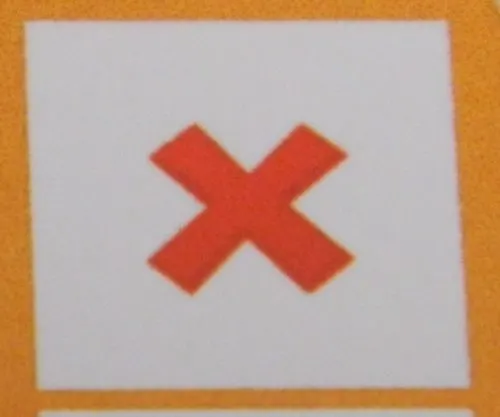
Whenever a player crosses off a red X symbol like this they will get to immediately cross off another space.
Coin Symbols
When a player crosses off a coin symbol they will cross off the next coin from their Score Card. Players will begin by crossing off the furthest left coin from the first row. If a player crosses off all of the coins from the first row they will move onto the furthest left coin of the second row and so on.
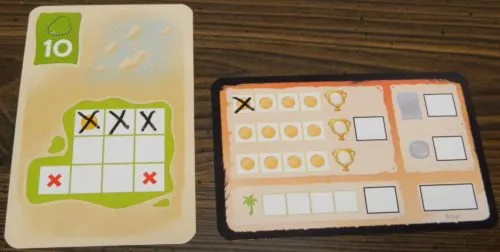
This player has crossed off a gold coin on their Treasure Card. They will cross off the first coin from their score card.
Once a player crosses off all of the coins from their Score Card they won’t cross off anything for any additional coins that are crossed off.
Palm Trees
If a player crosses off a palm tree symbol they will immediately score points. They will add up the number of palm trees shown on the four displayed Treasure Cards (the four cards in the middle of the table that don’t belong to any of the players). They will score one point for each palm tree plus one for the palm tree that they crossed off from their own card. This total will be written on the furthest left space of the palm tree section of their Score Card.
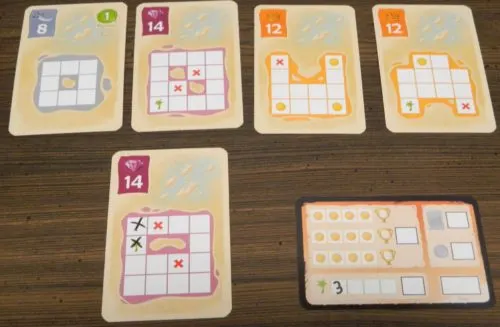
This player crossed off a palm tree. As there are two palm trees on the cards in the middle of the table, the player will score three points from the palm trees (two palm trees in the middle plus the palm tree they crossed off). They will write three on the first palm tree spot on their score card.
If two palm trees are crossed off on a player’s turn they will perform this process twice.
Complete Rows of Coins or Treasure Cards
Starting with the first player and proceeding clockwise, each player will have the opportunity to score points based on the boxes they filled in during the turn.
If a player has completed one of the rows of coins on their Score Card they will look at the Round Card to find the trophy that has the highest number on it. They will cross off this trophy and write the number that was on it next to the row of coins that they completed. If all of the trophies have been crossed off, the player will receive no points for completing the row of coins.
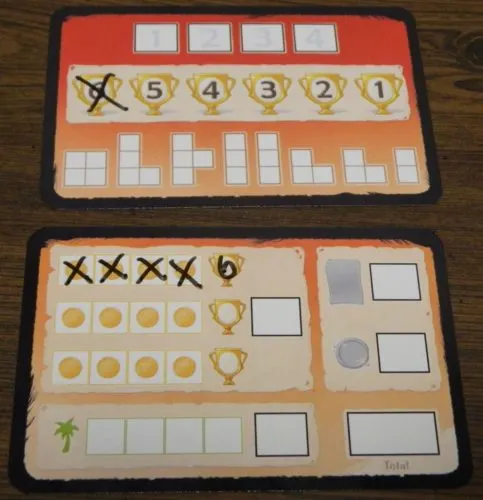
This player has crossed off all of the coins from their first row. As they were the first to do so they will score six bonus points which they will write on the trophy in the first row.
The player will then look to see if they have crossed off all of the boxes on one or both of their Treasure Cards. If the player has crossed off all of the boxes they will set the card to the side where everyone can see it as they will score points for it at the end of the game.
The player will then get to draw a Treasure Card to replace the one they finished. They can either choose one of the four cards face up in the middle of the table or they can choose the top card from the deck. If the player completed both Treasure Cards they will get to take two new cards. After a player has finished taking cards, new cards are turned face up to replace those taken by the current player. If you ever run out of Treasure Cards, you won’t replace the Treasure Cards that were taken.
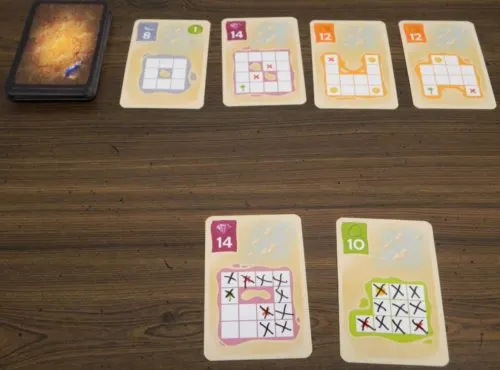
This player has finished crossing off the green card. They will get to take one of the face up cards or the top face down card as their next Treasure Card.
After all of the players have completed this step, the role of first player will pass to the next player clockwise. The next turn will then be played in the same way as the previous turn.
End of Round
A round ends after seven turns have been played (seven of the eight Exhibition Cards were used). The current round number is crossed off the Round Card. All eight Exhibition Cards are shuffled to start the next round.
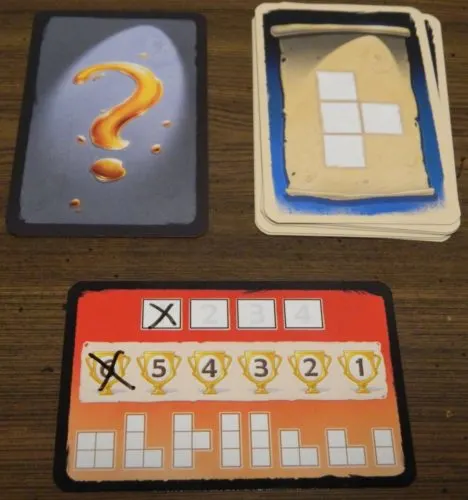
The players have completed the first round. They will shuffle the Exhibition Cards to start the next round.
End of Game
The game ends after the fourth round is completed. All Treasure Cards that aren’t completed will be set aside as they won’t score any points. Players will then count up their points as follows:
- Each crossed off coin on a player’s Score Card is worth one point.
- Each trophy on a player’s Score Card is worth the number of points written on it.
- Add up the numbers written on the palm tree boxes.
- Each Treasure Card that had all of its boxes crossed off will be worth points equal to the number in the top left corner.
- Some of the Treasure Cards will feature a seal of a specific color. For each Treasure Card you completed of the corresponding color you will score points equal to the number inside the seal.
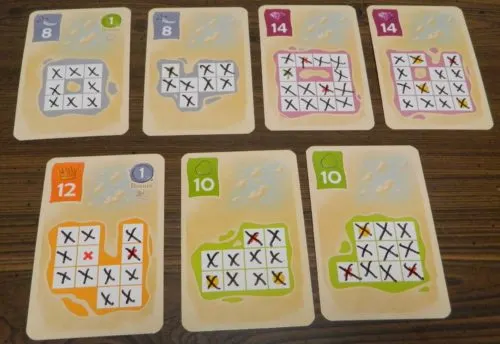
In the game this player completed seven cards. They will score a total of 76 points from these cards. The cards this player completed also feature two seals. One seal scores one point for each green card and the other scores one point for each gray card. They will score a total of four points based on the seals.
The player with the most points wins the game. If there is a tie, the tied player who completed the most grey Treasure Cards wins. If it is still tied players will compare the number of green cards completed followed by orange and finally purple.
My Thoughts on Silver & Gold
I have played a lot of different board games and I honestly don’t know if I could say that I have played a game quite like Silver & Gold before. This can be attributed to the fact that the game really feels like a blend of a bunch of different board game mechanics. At first glance one of the most obvious mechanics is the polyomino/Tetris mechanic. Next the game utilizes a flip and write mechanic which is a relatively new genre which spun off the older roll and write genre. The game even reminds me of Bingo in a way. This blend of mechanics reminded me a lot of other Phil Walker-Harding games that I have played.
Basically the premise of the game is that you are searching for buried treasure on various islands. Each player has two Treasure Cards in front of them. The objective of the game is to cross off all of the spaces on those cards in order to score points and get another card to cross off. On each turn a card is drawn which shows a pattern. This pattern shows a number of spaces that you can cross off on one of your cards. If you have available spaces on one of your cards in the pattern from the card you can cross them all off. If you can’t or don’t want to cross off the pattern though you are only able to cross off one space. In addition to finishing off cards you will also score points by crossing off gold coins or palm trees.
While the game is not perfect, Silver & Gold basically lived up to my expectations. In a lot of ways the game reminds me of the other games that I have played that were designed by Phil Walker-Harding. Hardcore gamers might find the game to be too simple, but I think the game does a great job creating a fun and engaging game that the whole family can enjoy.
I have alluded to this in other reviews of his games, but one of the things that I like most about Phil Walker-Harding’s games is that he does a great job with accessibility. One of my golden rules for board games is to not make a game more difficult than it needs to be. Silver & Gold excels in this area. At first glance some people might think the game looks complicated. I attribute most of this to the fact that the game is likely to be much different than any other games that they have ever played. The gameplay basically boils down to reveal a card and cross off spaces on one of your cards. The game couldn’t really get any simpler than that. Your first couple of turns might take a little time to get used to, but after that point you will have no issues as the gameplay is really straightforward.
This simplicity leads to the game playing surprisingly quickly. The game has an estimated length of 20 minutes and that seems about right. Once players are more familiar with the game I could see the length becoming even shorter. Your options on each turn are quite straightforward. There will be a couple turns where you might have a couple options to consider. In most rounds though you will know right away what you want to do. You will be really hard pressed to suffer from analysis paralysis in the game. This leads to most rounds only taking around a minute. With the short length Silver & Gold will work great as a filler game or you could easily play a couple games back to back.
With how simple the game is to play and the fact that most decisions are pretty obvious, you might be a little concerned that the game doesn’t feature much strategy. It is usually pretty obvious what you should do on each turn, but there is still enough strategy to the game. Your decisions in the game will have an impact on what ultimately happens. A good strategy might not always be able to overcome bad luck (more on this later), but bad decisions will almost guarantee your loss. Like Tetris the key to doing well in the game is trying to maximize the use of each Exhibition card that is revealed. You don’t want to leave straggler spaces because you will then have to waste a turn filling in just one space. There is skill in finding the right space to place the x’s from an Exhibition Card to leave spaces that can be filled in with another card.
I think this is one of the game’s greatest strengths. This mechanic of filling in your Treasure Cards is just so satisfying. In a way the game kind of feels like what Bingo would be like if there was actually some skill to it. Instead of just filling in the number that is called, you get a choice in what spaces you fill in. On top of this the game gives you a number of different ways to score in the game. While I think filling in cards usually gives you the most points, you can also score points by crossing off coin and palm tree spaces. The Treasure Cards you choose and which spaces you choose to cross off will have a pretty big impact on how well you will do in the game. Your decisions are usually pretty obvious, but the game does a good job making you feel like your actions have a real impact on the game’s outcome.
One mechanic in Silver & Gold that I haven’t really talked about yet is the fact that the game has a sort of memory element as well. In each round seven of the eight Exhibition Cards will be revealed. You know which cards are in the deck so you know what cards will come out during the round. The game does not let you look at the cards that have already been revealed in the round though. Therefore you should really try to remember which cards have been revealed as it will give you a good idea of what cards will come out for the rest of the round. This allows you to plan which spaces to leave open that you can fill on future turns. If you forget which cards have been revealed you are basically flying blind and just need to hope that you leave open spaces where you can use the future Exhibition Cards. While I am not generally a big fan of memory mechanics, I didn’t mind this one because it allows players to gain a little advantage over other players that don’t pay attention to the cards that have already been revealed.
This does allude to the game relying on a decent amount of luck though. As I mentioned earlier bad decisions could easily lose you the game. Smart strategic decisions won’t necessarily win you the game though. This is because there are elements of the game that are outside of your control. Most of the luck in the game comes from two main areas. The most obvious is the order that the Exhibition Cards are revealed. Remembering which cards have been revealed helps you plan some, but if the wrong card is drawn there is nothing you can do. Only getting to cross off one space instead of the entire pattern can be costly in the game. Having to take the one space a couple times is not going to end your game as it is basically impossible to avoid. Players that are forced into this decision a lot though have very little chance of winning the game.
The other area where luck comes into the game is the Treasure Cards that you have available to you when you are able to draw a card. Having four face up cards helps reduce the luck some as you can choose one of these four cards if it works for your current strategy. If none of these card are good for you though, you are forced to draw a random card from the draw pile. You could draw a card that really helps you, or you could draw a card that doesn’t really work with your other card. This could make it much harder to take advantage of future Exhibition Cards which could lose you spaces and contribute to you losing the game. The reliance on luck does not ruin the game, but players should be aware of the fact that you could lose Silver & Gold just because luck is not on your side.
I would say that one of the biggest issues that some players will have with Silver & Gold is that the game doesn’t actually feature a lot of player interaction. In a lot of ways the game does kind of feel like a solitary game. The only real player interaction in the game has to deal with the cards in the middle of the table as well as some competition for the points awarded for crossing off coins. Otherwise players could play the game by themselves and just compare their scores at the end of the game. While I wish the game would have a little more player interaction, I don’t see this as a big problem for the game. Everyone basically takes their actions at the same time which makes the game move quickly. In fact I think you could play the game by yourself even if the game doesn’t officially have a single player mode. This mode would basically just entail trying to beat a prior high score, but I think it could still be enjoyable. You would likely have to implement some house rules in order to make it work though. If you are the type of player that wants a lot of player interaction in your games, you may be a disappointed with this aspect of the game.
Before wrapping up I want to quickly talk about Silver & Gold’s components. At first glance you might not think that there is much to the game. The game’s box is surprisingly small for the game that it entails. This is mostly because the game utilizes the space really well. I found the game’s components to be quite good. The game mostly comes with just the cards and the dry erase markers. I will say that it is a little weird writing on cards and it takes a little time to get used to. That said the markers work surprisingly well on the cards. It is easy to write on the cards and they wipe off easily. In fact the cards wipe off better than almost any other dry erase components from a board game that I have played. I also thought the game’s artwork was quite good. I honestly didn’t have any complaints with Silver & Gold’s components.
Should You Buy Silver & Gold?
Based on the designer, premise, and theme I had pretty high expectations heading into Silver & Gold. Despite this the game actually lived up to my expectations. The game kind of feels like a combination of Tetris, Bingo, and a roll and write game. You basically draw cards and cross off spaces from your Treasure Cards trying to complete as many of them as you can. The game is really easy to play and it plays quickly. A lot of the decisions are usually pretty obvious, but the game has enough strategy to make it feel like you have a real impact on the game. The gameplay is just so satisfying. The components are great as well. Silver & Gold does rely on a decent amount of luck though and it doesn’t have a lot of player interaction. Ultimately Silver & Gold is another great game designed by Phil Walker-Harding.
My recommendations comes down to your thoughts on the premise and simpler games in general. If the premise doesn’t really intrigue you or you are looking for a complex game with a lot of player interaction, you likely won’t enjoy Silver & Gold. If the premise sounds interesting at all though and you are looking for a simpler game to play, you will likely really enjoy Silver & Gold and should consider picking it up.
Buy Silver & Gold online: Amazon, eBay
. Any purchases made through these links (including other products) help keep Geeky Hobbies running. Thank you for your support.

